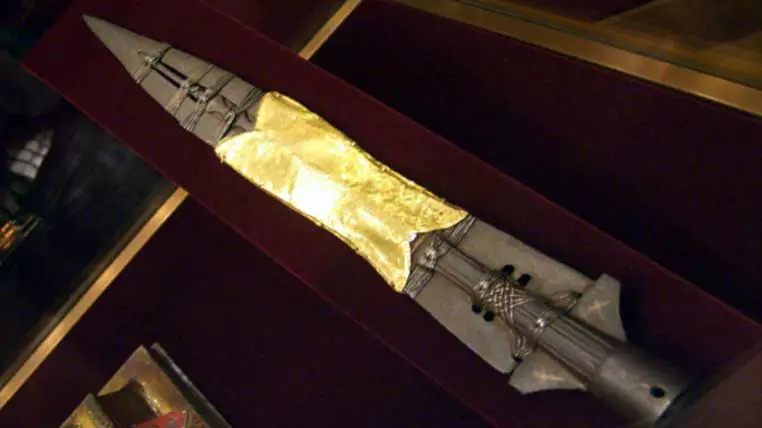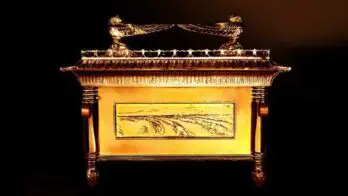The Holy Lance, also known as the Lance of Longinus or the Spear of Destiny, is one of history’s most important and controversial religious relics.
Legend has it that Christian knights discovered the sacred artifact in Antioch during the First Crusade in 1098.
The sight of the Holy Lance in the Church of Saint Peter is said to have inspired besieged Christian soldiers to mobilize and drive away the Saracens.
What Did the Holy Lance Look Like?
According to Christian tradition, the lance was the weapon a Roman soldier named Longinus used to pierce the side of Jesus Christ during the crucifixion.
The lance is believed to have mystical powers and has been the subject of many legends, myths, and controversies throughout the centuries.
The Holy Lance’s appearance has been described in various accounts and artistic representations throughout history, with some variations in details.
However, the most common description is a long spear made of iron, with a point at one end and a crossbar at the other. The shaft of the lance is said to be made of wood and decorated with gold and silver bands.
Holy Lance's Significance in Christian history
The legend goes that whoever holds the Holy Lance and can decipher its mystery holds the world’s fate in their hands, with the power to do either good or evil.
Although several European relics are claimed to be the original Holy Lance, the spear exhibited at the Vienna Weltliches Schatzkammer (Habsburg Treasury) museum is considered the only authentic. It has been housed in the museum for more than 250 years.
The lance itself is described by historian Jesús Hernández as a sharp iron spear over 50 centimeters long, repaired in part with silver.
The head of a nail and a strip of gold with the inscription “Lancea et Clavus Dominus” (eng. Lance and Nail of the Lord) can be seen in the central part of the lance. Small bronze crosses are also observed at its base.
The Holy Lance was a symbol of the power of the sovereigns of the Holy Roman Empire during their coronation, much like the globe and scepter used in the ascension of British monarchs.
In the Gospel of John 19:31-37, we have the scene when a roman soldier pierced the body of Jesus Christ on the cross.
The piercing caused by the Holy Lance was the fifth and final wound suffered by Jesus during his passions, and the soldier responsible was traditionally identified as a Roman centurion named Longinus.
According to the Bible, Longinus suffered from a painful illness that had affected his vision, which was miraculously cured by the few drops of blood and water that poured from the wound directly onto his face.
Later in the Gospel of Mark, Longinus is identified as one of the first Roman soldiers to convert and exclaim, “Truly, this man was the Son of God!”
The legends surrounding the Holy Lance are numerous, and many Christians believe that the holy relic possesses supernatural powers.
But contradictory stories follow the history of the lance, said to have been held by different saints or rulers over the centuries. In fact, its fame in the Middle Ages was not much different from that of the Holy Grail.
The Lance of Destiny
The lance has a long and storied history, with numerous accounts and stories about its origins and whereabouts over the centuries.
Many versions of the lance have been discovered, and there is no clear consensus on which one is the true Holy Lance.
However, the most well-known version of the lance was the one that Crusaders reportedly found during the siege of Antioch in 1098. The finding belongs to Peter Bartholomew, who wrote about the relic’s discovery in June 1098 in Antioch during the First Crusade.
The recovery of the relic is said to have inspired the crusaders to take up the offensive against the Muslims, crushing them in battle and ensuring Christian control of Antioch.
However, disputes over the lance’s authenticity caused dissent among the crusaders, and its discoverer, Peter Bartholomew, was eventually discredited.
Bartholomew, a humble peasant, claimed that Saint Andrew had appeared to him in a series of visions, revealing the lance’s location. He then informed the leaders of the First Crusade of his visions.
Although Bishop Adhémar of Le Puy was skeptical of their veracity, Count Raymond of Toulouse was impressed and ordered Bartholomew, along with a small group of crusaders, to search for the holy relic.
Bartholomew led them to the Cathedral of St. Peter in Antioch and pointed out where the Holy Lance had supposedly been hidden.
After a day of futile digging, Bartholomew asked the knights to stop and step away from the place where they had been digging. He then jumped into the hole and pulled out a piece of iron, which he claimed to be the Holy Lance.
Most of the crusaders accepted its authenticity and carried the lance into battle against the Muslims.
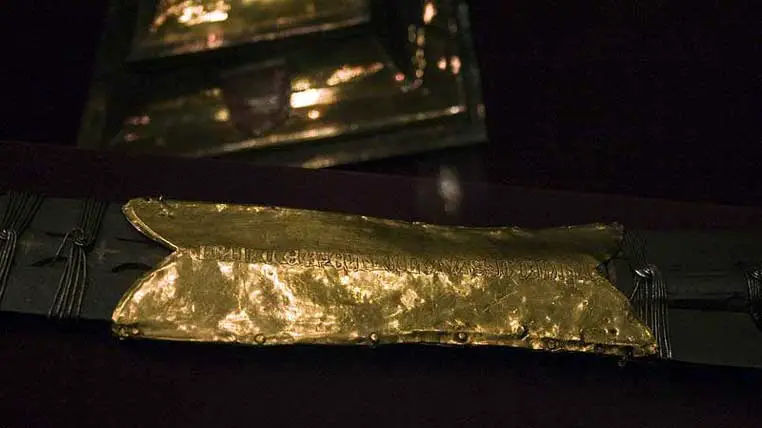
Soon after the lance’s unearthing, Bartholomew again claimed that Saint Andrew had appeared to him in a dream, offering clear instructions that the entire Christian army should follow to win the war against the Muslims.
However, the instructions provided by Bartholomew had become extraordinarily confusing and contradictory.
Furthermore, Bartholomew also attempted to discredit the late Bishop Adhémar of Le Puy – who had never believed in the lance’s authenticity discovered by Bartholomew.
All of this made the crusaders doubt the so-called “visions” and challenge the authenticity of the Holy Lance.
In a desperate last attempt to validate himself in front of the knights, Bartholomew submitted to a “trial by fire,” a perilous challenge that caused severe burns and ultimately resulted in his death.
The Holy Lance “discovered” by Bartholomew was definitively discredited, and Raymond de Toulouse’s prestige suffered immensely due to Peter’s visions being embraced.
Historical Accounts of the Lance of Destiny
Holy Lance association with Adolf Hitler and the Nazi Party has given rise to many myths and legends.
One of the most persistent is that Hitler believed the spear possessed paranormal powers that would help him in his wars of conquest.
According to Trevor Ravenscroft, author of the book “The Spear of Destiny” (1997), Hitler’s obsession with the spear began when he first saw it.
Ravenscroft claims that the spear became the “central pivot” of Hitler’s life and “the very source of his ambition to conquer the world.”
Hitler believed that the spear had been possessed by many powerful rulers before him, including Frederick the Great of Germany and Charlemagne.
He wanted to own the lance, along with other powerful Christian relics such as the Ark of the Covenant and the Holy Grail.
Ravenscroft also claims that Hitler often visited the museum where the spear was kept and entered into a trance-like state where he saw his future glory as the ruler of the Third Reich.
Hitler’s Obsession With the Occult and Religious Artifacts
Hitler shared his interest in the occult with his friend Walter Johannes Stein, an expert in the field. However, when Hitler was still an aspiring artist, Stein did not take his delusions of grandeur seriously.
After Hitler’s rise to power in 1933, he felt an ever-increasing need to possess the spear.
In 1938, when the Third Reich annexed Austria, Hitler triumphantly entered Vienna, where he had lived as a vagabond.
Accompanied by the head of the SS, Heinrich Himmler, Hitler went straight to the Hofburg Palace, where the spear was kept. Himmler left Hitler alone with the relic for over an hour.
During this time, Hitler had to come up with a plan to take the artifact from the museum without appearing to commit theft.
The Führer believed the spear had belonged to him in a previous life. In fact, he thought he was the reincarnation of a 9th-century feudal lord called Landulfo II of Capua, who had been excommunicated by the Pope for being a powerful magician.
The artifact was “confiscated” based on paperwork sent from Berlin through the mayor of Nuremberg, Willy Liebel, to make it appear legal.
Allegedly, Lievel wanted the famous treasure to be returned to Nuremberg, where it was displayed in the past, before being moved to Vienna.
Of course, everything was just a facade. In reality, all the papers were counterfeit, and Hitler wanted the Holy Lance for himself.
After achieving their goal, the Nazis had to protect the Spear until it arrived in Germany alongside the other 31 pieces of the Austrian treasure.
Preparations for the departure had taken five months, and they resorted to an armored train to transport the treasure. On August 29, the relic left Vienna in utmost secrecy.
The following day, the Holy Lance was returned to the Church of Saint Catherine, in Nuremberg. Willy Liebel welcomed the relic with all the honors.
According to Hernández, Hitler’s obsession with the Holy Lance was connected to his passion for Wagner’s works, with his favorite being Parsifal, where the legend of the Holy Lance and the Holy Grail played a central role.
The Holy Lance Is Recovered
We will never know if Hitler’s immense power between 1938 and 1942 was due to the artifact, but during these four years, his troops were invincible.
However, his power began to decline in 1942 when German troops started losing battles on all fronts.
At that time, the relic was no longer exposed to the public but was kept in a permanent air-raid shelter dug deep into the stone beneath the Kaiserburg Castle in Nuremberg.
On March 31, 1945, before the Allied troops advanced into German territory, Liebel believed the shelter did not provide enough protection, so he placed the Holy Lance in a metal crate in the Panier Platz bunker.
After the fall of Berlin, Walter Horn, a medieval studies scholar who had fled Nazi Germany and served in the Third Army under General George S. Patton, became the lead investigator in the Monuments, Fine Arts, and Archives Program, which sought to locate and reassemble the hidden Imperial Regalia collection of the Nazis during the war.
After conducting extensive research and interviews, Stadtrat Fries, a counselor of Nuremberg, confessed to hiding missing pieces of treasure along with another counselor, Stadtrat Schmeissner, and an SS officer.
They agreed to lead Horn’s team to the site.
On August 7, Horn and an American army captain escorted Fries and Schmeissner into the Panier Platz bunker.
They found the hidden treasure behind a wall in a room at the end of an underground corridor approximately 80 meters below the ground.
The artifacts found in the bunker were then transferred to Nuremberg Castle, where the Imperial Regalia collection was reassembled.
The entire collection was officially transferred to Austrian officials in January of the following year.
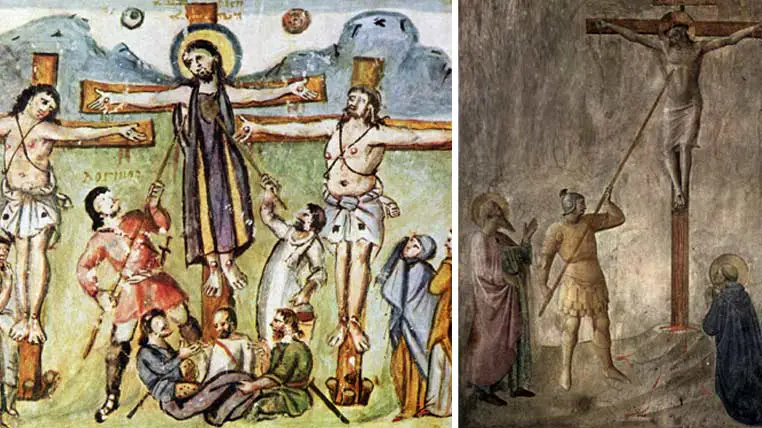
Where is the Holy Lance Now?
During the reign of Constantine and in the early centuries of Medieval Europe, numerous reports about the Holy Spear started to emerge.
It soon became evident that multiple spears were identified as the one that had pierced Jesus’ body on the cross.
However, only three were seen as “potentially authentic”: the Spear of the Vatican, the Spear of Vienna (Habsburg), and the Spear of Vagharshapat (Echmiadzin).
The Lance of the Vatican
A relic believed to be the Holy Lance is kept in St. Peter’s Basilica in Rome, although the Catholic Church has never claimed that the relic is authentic.
The first historical reference to this lance was made in 570 AD by an unknown pilgrim from Piacenza (often mistakenly identified as St. Antoninus of Piacenza) in his writings about the holy places of Jerusalem.
This pilgrim wrote about two religious artifacts he had seen in the Basilica of Mount Zion: “the crown of thorns with which our Lord was crowned and the lance with which he was struck on the side.”
The same lance is mentioned in the Breviarium of the Church of the Holy Sepulchre.
The supposed presence of the relic in Jerusalem is attested by Cassiodorus (c. 485-585) and Gregory of Tours (c. 538-594), although the latter had never been to Jerusalem.
In 615, Jerusalem was captured by the Persian forces of King Khosrau II (Chosroes II).
According to the Chronicle of Paschal, the tip of the lance, which had been broken off, was offered that same year to Nicetas, who took it to Constantinople and deposited it in the Hagia Sophia church and later in the Church of the Virgin.
This tip of the lance was acquired by Emperor Baldwin II of Jerusalem (1075-1131). A few decades later, the artifact ended up in possession of King Louis IX of France (1214-1240).
The tip of the lance and the crown of thorns were placed in the Sainte Chapelle in Paris. Both relics were hidden at the Bibliothèque Nationale in Paris during the French Revolution.
As for the more significant portion of the lance, Arculpus claimed to have seen it at the Church of the Holy Sepulcher around 670 in Jerusalem, but there is no reliable mention of it after the devastation of 615.
Some claim that the larger part of the relic was transported to Constantinople in the 8th century, possibly at the same time as the crown of thorns.
In any case, various pilgrims, especially the Russians, clearly attested to its presence in Constantinople.
Sir John Mandeville declared in 1357 that he had seen the blade of the Holy Lance both in Paris and Constantinople and that the latter was a much larger relic than the first.
It should be added that Mandeville is not considered one of the most reliable medieval witnesses, and his supposed travels are usually treated as an eclectic amalgam of myths, legends, and other fictions.
Authentic or not, the lance from Constantinople ended up in the hands of the Turks, and, in 1492, in the circumstances described in detail in Pastor’s History of the Popes, Sultan Bayezid II offered it as a gift to Pope Innocent VIII to convince him not to release Bayezid’s brother and rival, Cem Sultan.
However, most cardinals and experts from Rome expressed skepticism about the authenticity of the lance received by the Pope, as noted by Johann Burchard, as several other similar artifacts had already appeared in Paris, Nuremberg, and Armenia.
In the middle of the 18th century, Pope Benedict XIV obtained an exact drawing of the point of the lance displayed in France from Paris.
Comparing the image with the rest of the relic displayed in St. Peter’s Cathedral in Rome, the Pope was confident that both blades were actually from the same spear point.
The Holy Lance of Vienna
The Holy Lance of Vienna is housed in the Imperial Treasury, or Weltliche Schatzkammer (eng. “Chamber of Worldly Treasures”), at the Hofburg Palace in Vienna.
According to writings from the time of Otto I (912-973), the Holy Roman Emperors came into possession of the artifact at the beginning of the 10th century.
It is said that this spear belonged to Constantine the Great and later to Saint Maurice.
In 1000, at the Congress of Gniezno, Otto III offered a replica of the Holy Lance to Bolesław I of Poland.
In 1084, Henry IV attached a silver plate inscribed with “The Lord’s Nail” to the original artifact after noticing a metallic, elongated object attached to the artifact’s point.
However, it was only in the 13th century that people first spoke of a supposed connection between Constantine’s lance and the one used by the Roman soldier Longinus to pierce Christ’s body on the cross.
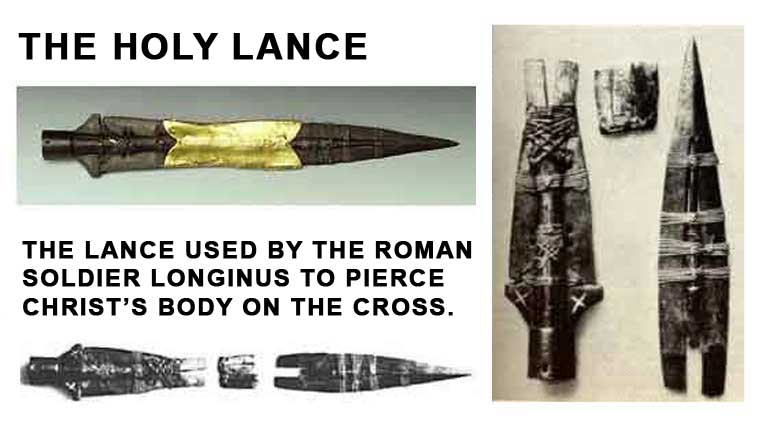
In 1273, the Holy Lance was used for the first time in a coronation ceremony.
Around 1350, Charles IV attached a gold sheet inscribed with Lancea et clavus Domini (eng. “The Lord’s Lance and Nail”) over the silver strip added by Henry IV in 1084.
In 1424, Sigismund moved an impressive collection of religious objects, including the lance, from Prague to his hometown of Nürnberg and decreed that the valuable objects should be kept there forever.
This collection was given the name of Imperial Regalia (Reichs Kleinodien).
When the French revolutionary army approached Nuremberg in the spring of 1796, the city councilors moved the Imperial Regalia to Vienna, where the objects would be kept safe.
The collection was entrusted to Baron von Hügel, who promised to return the objects after the French troops were defeated.
However, in 1806, the Holy Roman Empire collapsed, and von Hügel sold the collection to the Habsburgs, who had just taken power.
The counselors from Nuremberg requested the artifacts’ return after Napoleon’s army’s defeat in the Battle of Waterloo, but the Austrian authorities refused.
During the Anschluss, when Austria was annexed by Germany, the Nazis moved the entire Reichs Kleinodien collection back to Nuremberg, where the objects were exhibited during the Party Congress in September 1938.
Then, the relics were transferred to the Historischer Kunstbunker, a bunker built under Nuremberg Castle to protect valuable objects during air raids.
A large portion of the treasure was recovered by Allied forces at the end of the war, but the Nazis had hidden the most important pieces in hopes of being able to use them as symbols of power to help them regain control.
The Holy Lance of Vienna Authenticity Controversies
In an extraordinary precedent in January 2003, Robert Feather, an English metallurgist and engineer was granted access to the artifact for analysis in a documentary.
Feather examined the lance in a laboratory and removed the delicate gold and silver bands that held it together to determine its age.
Using several complex procedures and laboratory analyses, all non-invasive procedures, Feather dated the main body of the lance as early as the seventh century.
In the same documentary, Feather concluded that the iron nail – which had long been claimed to be a nail from the crucifixion, hammered into a blade – was “consistent” in length and shape with a Roman nail from the first century AD.
However, the analyses did not identify human blood residue on the lance.
Feather’s analysis was followed by a series of complex examinations conducted by researchers at the Institute for Archaeological Research and Analysis in Vienna.
They compared the Lance of Destiny to other similar spears using X-rays and other modern technologies.
They determined that the artifact on display in Vienna dates from around the eighth century to the beginning of the ninth century.
They also determined that the nail at the tip of the lance is made of the same metal as the rest of the lance, thus ruling out the possibility that it dates from the first century AD.
The Vagharshapat (Echmiadzin) Lance
In Vagharshapat, the religious capital of Armenia, another lance is kept, believed to be the true Holy Lance.
This spear was kept for a long time in the Geghard Monastery.
The first source to mention it is a text fragment from The Holy Shroud of Our Lord Jesus Christ, an Armenian manuscript from the thirteenth century.
According to the text, the lance that pierced Jesus was brought to Armenia by the apostle Thaddeus.
The manuscript does not specify where and how the relic was kept, but the description in the text matches the Lance of Destiny exactly.
In 1655, the French traveler Jean-Baptiste Tavernier was the first Westerner to see this relic in Armenia.
In 1805, the Russians captured the monastery, and the relic was moved to Tchitchanov Geghard, Tbilisi, Georgia.
It was returned to Armenia and is currently displayed at the Manoogian Museum in Vagharshapat.
At Ancient Theory we only use trusted sources to document our articles. Such relevant sources include authentic documents, newspaper and magazine articles, established authors, or reputable websites.
- The Spear of Destiny Explained. museumreplicas.com.
- Holy Lance. wikipedia.org. [Source]
- Aleksa Vučković - Piercing the Veil: Uncovering the Secrets of The Holy Lance.
- Dean Traylor - The Legend of the Spear of Destiny and the Creator of Tyrants.
- Spear of Destiny. encyclopedia.com. [Source]
- Holy Lance. britannica.com. [Source]
- Holy Lance. newworldencyclopedia.org.
- Howard A. Büchner and Wilhelm Bernhart - Adolf Hitler And The Secrets Of The Holy Lance. Thunderbird Press, 1988.
